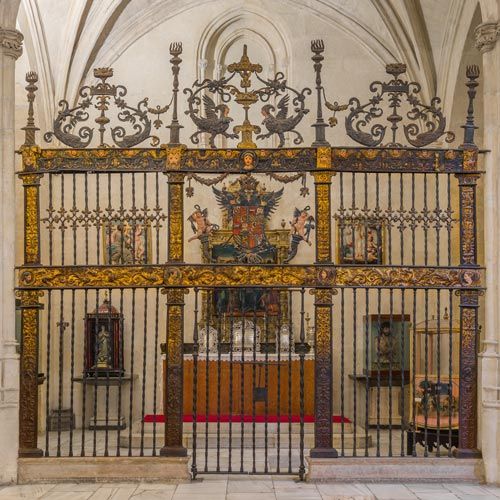Gothic, Renaissance, Baroque. The Baroque most significant presence in the Royal Chapel is represented by two cabinet-altarpieces, the Holy Cross Chapel altarpiece, and Baroque sculptures. By a Philip IV (1630) Royal Dispatch it was ordered to build the current reliquary–altarpieces in the transept, where an important relic collection should be placed. This collection was donated by the Kings who had previously received it from the Popes.
THE CABINET RELIQUARY ALTARPIECES
Contemplating these two altarpieces —works by Alonso de Mena (1587-1646)— we come closer to their shapes and richness, and to their iconography, without ignoring the spectacular dimension. When opening their doors, we discover the theme’s abundance and the shapes and materials richness.
At a lower level, on their benches, and over workable doors, portraits in relief of the Kings can be seen: Ferdinand and Isabella, Philip and Joanna, Charles and Isabella, Philip IV and Isabella of Bourbon, as witnesses and prayers.
Above the big door, and within four rectangular spaces, St. Michael and St. Santiago, St. Joseph itinerant and, possibly, St. Philip, the reigning monarch patron Saint, appear in relief in the right side altarpiece.
In the left side altarpiece, the Blessed Virgin, St. John the Baptist, St. Peter, and St. Paul can be seen. In both altarpieces centres and above the joint of their two main doors locks, two big Spain Coats of Arms, along with the yoke-and-arrows, highlight the composition royal rank.
THE HOLY CROSS CHAPEL
The Baroque altarpiece, which is divided into three streets and erected in two floors, takes up the whole chapel back up to the gothic vaults base. In the middle and making best use of the exterior wall open window, it can be seen the Holy Cross with a dramatic effect against the light. Conceived as a triumph symbol, it is framed by apotheosis and wealt.
The electric light presence in this scenery converts these spaces into a visual show. Here, one of the most important episodes, in order to understand the Baroque didactic and emotional contents, is materialised, with the weak and natural illumination the proper atmosphere for these spaces and works is found.
To increase the faithful or mere observers attraction, two polychromatic half figures, carved in wood, of the Ecce Homo and Our Lady of Sorrows are placed on both sides. Their close and self-controlled expression invites, in contrast with the richness of the back of the altarpiece, to a devout meditation and a careful contemplation.
Both pieces of work are completely characteristic of the best period of the Granada Baroque Sculpture. They are derived from types and models by José de Mora (1642-1724), on which Risueño, to whom this work is attributable, could add a softer modelling and a closer approach to painting.
OTHER SIGNIFICANT SCULPTURES
In the entry to the Cathedral, there is the Holy Family, a valuable Renaissance group of sculptures by Bernabé de Gaviria, in front of a sculpture of Saint John of Capistrano, a Baroque-style piece by Bernardo José de Mora.
In the Chapel of Saint Ildephonsus, there are two Renaissance reliefs of the Holy Cross and the Creation of Eve, next to a valuable bust of the Ecce Homo by Bernardo José Mora.









